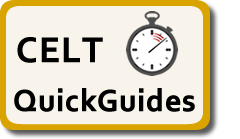 CELT QuickGuides contain brief step-by-step guides to some of the basic procedures when using the core teaching and learning technologies at DMU.
CELT QuickGuides contain brief step-by-step guides to some of the basic procedures when using the core teaching and learning technologies at DMU.
Click the headings below to expand the sections.
|
Panopto QuickGuides |
|
Turnitin QuickGuides |
 CELT QuickGuides contain brief step-by-step guides to some of the basic procedures when using the core teaching and learning technologies at DMU.
CELT QuickGuides contain brief step-by-step guides to some of the basic procedures when using the core teaching and learning technologies at DMU.
Click the headings below to expand the sections.
|
Panopto QuickGuides |
|
Turnitin QuickGuides |